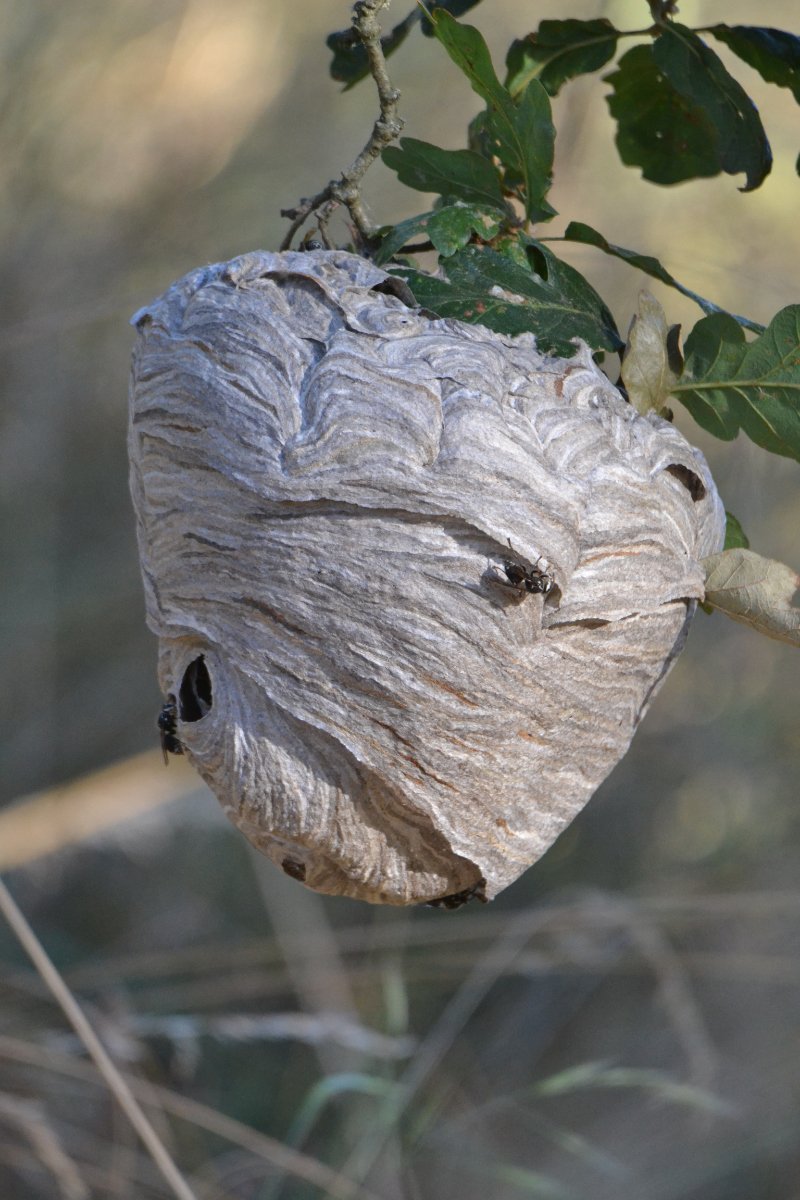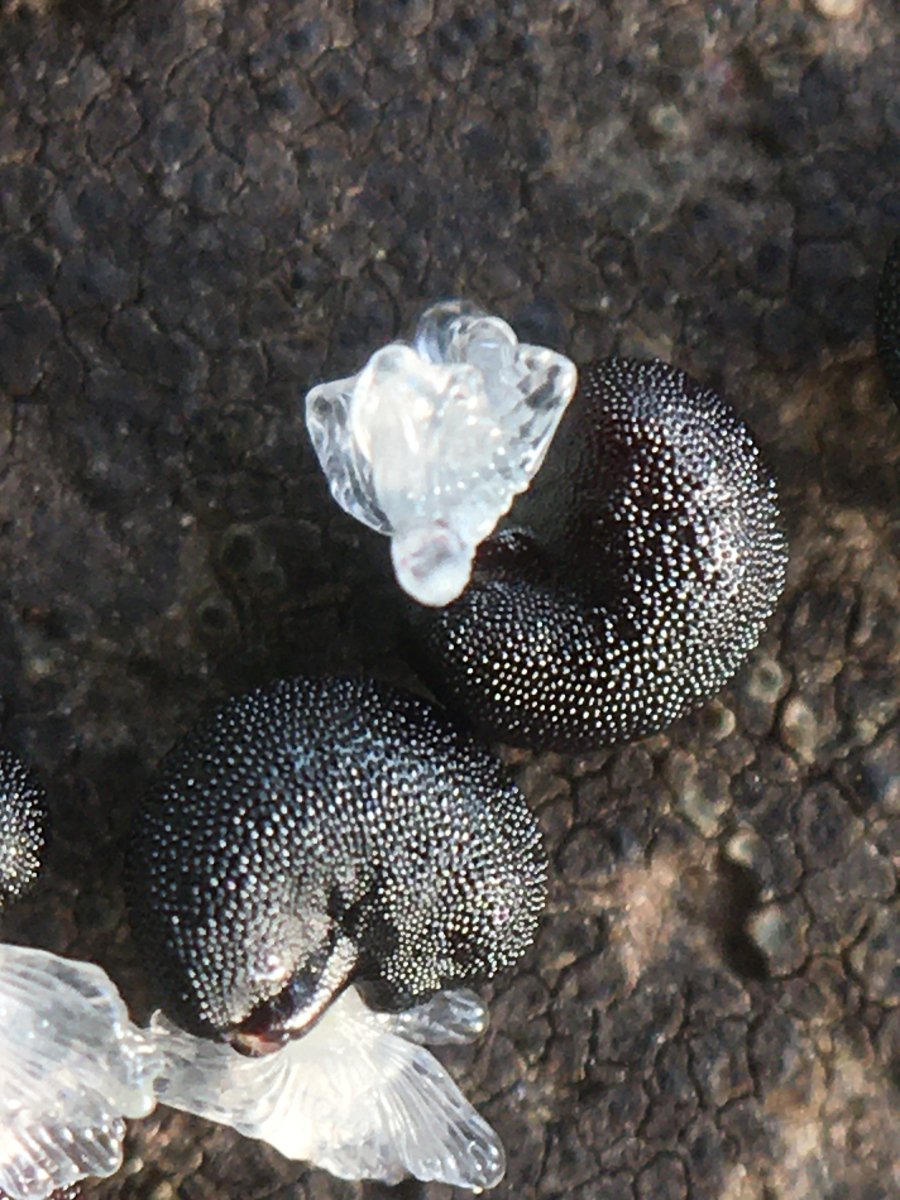With the end of August approaching, I am surprised to see that snowberry flowers are continuing to emerge. I looked back and found that I had taken photos of it flowering in May. I see many insects visiting the blooms, and I am reminded of how valuable this native plant is as a nectar source.
Bald-faced Hornet
Out at the end of this oak branch is a paper nest of the bald-faced hornet. The adult hornet is 5/8-3/4” long. They have black and white patterns on the face, thorax, abdomen, and first antennal segment. The wings are a smoky coloration.
The nest is constructed of wood pulp. I usually find a hornet on the posts of an old wooden fence along the river trail where they gather the top, soft layer of gray fibers. The nest is built in many layers of cells that are covered from the outside. In the end, the nest becomes this striated swirl of grays that is beautiful and sturdy.
The main entrance of the nest is placed at the bottom. This is easy to see in the second photo of the nest below. I just took this photo yesterday evening. This is the second attempt at building the nest. The first one was torn down. A serious word of caution. The adult hornets are very protective of the nest, and they will not hesitate to defend it if you get too close. They can sting repeatedly, and from my own experience, it is painful!
The diet of the adult consists of nectar, fruit juices, and perhaps eats other insects. The larva feed on insects that are pre-chewed by the adults.
In the late summer, the colony starts to produce males and young queens that will mate. The young mated females will overwinter in the soil or leaf litter—all of the other hornets will die off. The young queen will emerge next year to start a new colony.
At the bottom, there are a couple of photos of a bald-faced hornet on an oak limb that has these red nodules which I think are a type of gall. Maybe the hornets are attracted to these galls because the galls excrete plant juices that they can eat. I haven’t been able to find out more about it yet.
References
Milne, Lorus Johnson, and Margery Milne. The Audubon Society Field Guide to North American Insects and Spiders. Knopf: distributed by Random House, 1980.
Fly Larvae
Some flies stirred as I was walking down the path, and I looked over to see a dead snake. As I bent down to take a closer look, I saw that it was teeming with fly larvae inside its body. I was reminded of nature’s cycle of life. The purpose, strength, spirit, and medicine of so many unsung organisms that break down, transform, and recycle all of creation back into the stream of life are unbelievable.
River Jewelwing
This damselfly is truly a jewel with its iridescent blue body forged from stardust. The outer third of its wing is sooty—singed by the sun on its cosmic journey to earth. Its legs of wicker form a basket collecting and cradling our dreams. When we reawaken to our connection to nature, we will remember that we are all one.
Water Strider
The small, ephemeral stream that flows off the hillside next to the white oak pavilion is still softly trickling. As I follow the stream up the trail, there are places where the water is continuing to fill shallow pools.
In these pools, oval shadows ringed with light dance around the floor. Creating this celestial event are water striders! Where their feet contact the surface, it makes small dimples that are eclipsing the sun.
Miraculously, the surface tension of the water holds them up. They also have tiny hairs on their feet that trap air bubbles that help them stay buoyant and allow them to easily propel themselves along.
As distant images of the cosmos are streaming into our world from the James Webb telescope, these small pools remind me of the infinite universe contained within our planet earth.
Bleeding Heart Seed Pod
The bleeding hearts are forming their seed pods. The pods grow out of the corolla mouth and can be up to 2” long. The seeds are c-shaped, black, and have a pebbled, shiny surface. On one end is a white, oil-rich appendage known as an elaiosome, which is attractive to ants. They will collect the seed to eat the elaiosome and discard it, thus helping to disperse it.
There were 18 seeds in the pod I opened. I took them over to some ants and dropped the seeds in their path. They immediately investigated them, and within about 1 minute, all the seeds were carried off. It is amazing all the interesting ways seeds are spread.
As I looked at the seed more, the shape of it and the white elaiosome (rich in lipids and proteins) attached to the end reminded me of a small fortune cookie. I am sure the ants would agree that it was a fortuitous find.
Oak Treehopper Adults
The oak treehopper nymphs (see post on April 25) have been becoming adults over the past week or so. The diversity in form and color in the insect world is spectacular.
Blue Butterfly
A cool, quiet blue dye
delicately tints
the ephemeral life
that lives in all eternity
softening my eyes
and lightening the path
as I walk along
collecting memories.
Oak Treehoppers
Once I saw these amazing creatures congregating on the end of a small twig, I couldn’t remember why I originally walked over to this particular oak tree. I called my friend Don over to have a look, and he exclaimed, “They’re Oak Treehoppers!”
The nymphs of the oak treehopper look fairly ominous. They are boldly colored black, red, and white. In addition, they have spikes on the top of their body and red eyes. As they grow and develop, they will change colors and patterns. So, I’ll be going back to check on them regularly to see how they evolve and take some photos.
Next to the nymphs was an adult treehopper. I didn’t see this adult at first because she resembled a small tree bud. The adult treehoppers become well-camouflaged as they mature turning olive-brown with yellow dots. This is the female, and she will stay around to stand guard and protect her nymph colony as they grow.
Treehoppers drink the sap of the tree.
Caddisfly Larva
While looking in the small pools in the parking lot for frog eggs, I found a caddis fly larva. It was waddling around the pool searching for algae and other organic debris to eat. It makes the most beautiful, mobile home in the larval stage.
Depending on the environment, the larva gathers plant material, leaves, twigs, sand, small rock fragments, or other detritus, to build its temporary home. It cements it together with salivary silk forming a cylindrical tube. It lives inside this camouflaged, protective casing as it develops. When it is fully grown, it closes the tube ends and pupates inside. After this stage, it will cut open the case, rise to the surface of the water, undergo a final molt, and begin flying. As an adult, it usually only lives for a few weeks. During this time it focuses on reproduction. Most species do not eat as an adult, but a few species will visit flowers for nectar.
I have a photo of the adult somewhere in my album. When I find it, I will post it.































